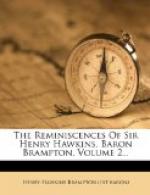So far as he was concerned I was not satisfied with the conviction. “Is it possible,” I asked myself, “that there can have been a mistake?” I did not think that in the excitement of such a moment, and during so fearful a struggle with his antagonist, with their faces so close together that they stared into each other’s eyes, there was such an opportunity of seeing the youth’s face as to make it clear beyond any doubt that he was the man who committed the crime. The jury, I thought, had judged too hastily from appearances—a mistake always to be guarded against.
I invited the prosecuting counsel to come to my room, and asked him, “Are you satisfied with that verdict so far as the youngest prisoner is concerned?”
“Yes,” he said; “the jury found him ‘Guilty,’ and I think the evidence was enough to justify the verdict.”
“I do not,” I said, “and shall try him again on another indictment.” There was another involving the same evidence.
I considered the matter very carefully during the night, and weighed every particle of evidence with every probability, and the more I thought of it the more convinced I was that injustice had been done.
First of all, to prevent the men who I was convinced were rightly convicted from entertaining any doubt about the result of their conviction, I sentenced them to penal servitude.
I then undertook to watch the case on behalf of the young man myself, and did not, as I might have done, assign him counsel.
The prisoner was put up for trial, and the second inquiry commenced. It had struck me during the night that there was a point in the case which had been taken for granted by the counsel on both sides, and that that point was the one on which the verdict had gone wrong. As I have said, I did not doubt the honest belief of the keeper, but I doubted, and, in fact, disbelieved altogether in, the power of any man to identify the face of another when their eyes were close together, as he had no ordinary but a distorted view of the features. In order to test my theory on this matter, I took the real point in the case, as it afterwards turned out to be. It was this: Five men were taken for granted to have been in the gang and in the field on that occasion. The difficulty was to prove that there were only four, and then to show that the young man was not one of the four. These two difficulties lay before me, but I resolved to test them to the utmost of my ability. The Crown was against me and the Treasury counsel.
I knew pretty well where to begin—which is a great point, I think, in advocacy—and began in the right place. I must repeat that the prisoner boldly asserted, when the evidence was given as to the finding of his cap close to the spot where the outrage was committed, that it was his cap, but that he had not worn it on that night, having lent it to one of the other men, whom he then named. This was, to my mind, a very important point in this second trial, and I made a note of it to assist me at a later period of the case. If this was true, the strong corroboration of the keeper’s evidence of identity was gone. Indeed, it went a good deal further in its value than that, for it may have been the finding of the prisoner’s cap that induced the belief that the man whose face he saw was the prisoner’s!




